I've always used a graduated measuring spoon to measure out my 60 grains of Pyrodex for my .50 cal. Hawkin. Then I thought I'd use my powder scale that I use for reloading to weight out a more consistent measure. I found out my 60 grains from the spoon weight in at 43.4 grains on the scale. Are they two different grain systems?
You are using an out of date browser. It may not display this or other websites correctly.
You should upgrade or use an alternative browser.
You should upgrade or use an alternative browser.
Volume vs. weighing in grains
- Thread starter Nick S.
- Start date
bedbugbilly
New member
As you already know from reloading . . . 7,000 grains equals 1 pound - regardless of it it is powder or lead.
Not questioning your findings at all . . . just commenting from my own experiences. I have always used real black powder - been using it for 50 + years. And . . . for my BP pistols & front stuffers . . I've always used an adjustable brass measure. As I was taught many years ago . . like over 50 years . . . by a gunsmith who taught me how to shoot BP . . his advice was always "use what's needed to get the job done but not so much as you waste any". And . . for rifles . . start with 1 grain per caliber . . i.e. 40 caliber use 40 grains.
So . . when I started to load BP cartridges . . which of course take a compressed load . . . I developed a measure out of a cartridge casing that was based on the seating depth of my lead slug and that allowed for compression when the slug was seated. example: I found that a Colt 38 Long was just right topped off at the top o the casing for my 38 Special loads.
So then . . . i also proceeded to use my adjustable brass measure that I've used for years. I load my 38s with 3F Goex. In the process, I decided to weigh the volume charge on my powder scale to see how close the grain weights were . . . and of course . . . they varied.
If you are wanting to play with it . . it would be interesting to weigh your charges to keep them consistent . . . say 20 of them . . and then use your volume measurement to see what the difference is in your accuracy results. My guess . . and it's only a guess is that perhaps the volume measurement you've worked up for your loads will be just as accurate as weighed charges . . even though there may be a slight difference in volume from one charge to the next.
What I did learn on my BP cartridges is that I will continue to use volume charges rather than weight charges. It just seems to work better . . at least for me. Even though the BP is "screened" for consistency . . there can still be a difference from batch to batch (lot numbers). Actual size of the grains can make the density vary somewhat as far as volume measurement as opposed to actual grain weight. i.e. . . if you weigh grain weight charges - they should probably be in the + or - of .1 grain - what you would expect with smokeless. BP? Due to size of grains of actual lot number . . by volume you might be measuring say 40 grains but by actual weight . . . the grain weight would probably vary some . . certainly more than + or - .1 grain.
The good thing with BP (and I have no experience with substitutes like Pyrodex, etc.) over smokeless powder . . . a variance in volume measurement is not going to have catastrophic results like it would with smokeless powder.
Jst my thoughts and experiences . . . . and if the load you are using now (40.3 gr. by weight) - 60 grain by your volume measurement . . if it is giving good accurate results in your rifle . . . then there is no real reason to bump it up to 60 gr. by actual weight just so the grain weight matches what your scoop says . . . IMHO
Good luck and have fun!
Not questioning your findings at all . . . just commenting from my own experiences. I have always used real black powder - been using it for 50 + years. And . . . for my BP pistols & front stuffers . . I've always used an adjustable brass measure. As I was taught many years ago . . like over 50 years . . . by a gunsmith who taught me how to shoot BP . . his advice was always "use what's needed to get the job done but not so much as you waste any". And . . for rifles . . start with 1 grain per caliber . . i.e. 40 caliber use 40 grains.
So . . when I started to load BP cartridges . . which of course take a compressed load . . . I developed a measure out of a cartridge casing that was based on the seating depth of my lead slug and that allowed for compression when the slug was seated. example: I found that a Colt 38 Long was just right topped off at the top o the casing for my 38 Special loads.
So then . . . i also proceeded to use my adjustable brass measure that I've used for years. I load my 38s with 3F Goex. In the process, I decided to weigh the volume charge on my powder scale to see how close the grain weights were . . . and of course . . . they varied.
If you are wanting to play with it . . it would be interesting to weigh your charges to keep them consistent . . . say 20 of them . . and then use your volume measurement to see what the difference is in your accuracy results. My guess . . and it's only a guess is that perhaps the volume measurement you've worked up for your loads will be just as accurate as weighed charges . . even though there may be a slight difference in volume from one charge to the next.
What I did learn on my BP cartridges is that I will continue to use volume charges rather than weight charges. It just seems to work better . . at least for me. Even though the BP is "screened" for consistency . . there can still be a difference from batch to batch (lot numbers). Actual size of the grains can make the density vary somewhat as far as volume measurement as opposed to actual grain weight. i.e. . . if you weigh grain weight charges - they should probably be in the + or - of .1 grain - what you would expect with smokeless. BP? Due to size of grains of actual lot number . . by volume you might be measuring say 40 grains but by actual weight . . . the grain weight would probably vary some . . certainly more than + or - .1 grain.
The good thing with BP (and I have no experience with substitutes like Pyrodex, etc.) over smokeless powder . . . a variance in volume measurement is not going to have catastrophic results like it would with smokeless powder.
Jst my thoughts and experiences . . . . and if the load you are using now (40.3 gr. by weight) - 60 grain by your volume measurement . . if it is giving good accurate results in your rifle . . . then there is no real reason to bump it up to 60 gr. by actual weight just so the grain weight matches what your scoop says . . . IMHO
Good luck and have fun!
What is that?...always used a graduated measuring spoon...
DD4lifeusmc
New member
yes grains by weight and grains by volume.
Plus powder comes in different size granulations.
so 60 grains by volume of fffg will not be the same volume as 60 grains of ffg
And in this case( black powder) the weights won't be the same either.
BP and all the subs are to be measured by volume only.
But if you know the weight of your load as measured by volume you could do that load by weight.
But if you change powder type or granulation ( 777 vs pyrodex vs bp and ffg vs fffg or ffffg) then you will have to re measure the load by volume first and then by weight.
But still it is better to just use the volume!
Plus powder comes in different size granulations.
so 60 grains by volume of fffg will not be the same volume as 60 grains of ffg
And in this case( black powder) the weights won't be the same either.
BP and all the subs are to be measured by volume only.
But if you know the weight of your load as measured by volume you could do that load by weight.
But if you change powder type or granulation ( 777 vs pyrodex vs bp and ffg vs fffg or ffffg) then you will have to re measure the load by volume first and then by weight.
But still it is better to just use the volume!
Volume to weight equivalents of BP and some substitutes:
http://www.curtrich.com/BPConversionSheet.htm
http://www.curtrich.com/BPConversionSheet.htm
Most all serious target shooters at Friendship weight their powder. On the slug
gun range you will see their powder scales right on the bench and they will
weight every shot. I know in pistol shooting I use 15 grains of Swiss FFF. This
is NOT by volume but actual weight. All the people I shoot with weight their powder. I would be willing to bet that "Rookie" on this fourm who did well at
Friendship last week, who uses 17 grains Goex in his Remington would tell you
that is by weight, not volume. I don't see how anybody who uses the volume
method would really know what they are doing. I have been at this for over
50 years Weight it!
gun range you will see their powder scales right on the bench and they will
weight every shot. I know in pistol shooting I use 15 grains of Swiss FFF. This
is NOT by volume but actual weight. All the people I shoot with weight their powder. I would be willing to bet that "Rookie" on this fourm who did well at
Friendship last week, who uses 17 grains Goex in his Remington would tell you
that is by weight, not volume. I don't see how anybody who uses the volume
method would really know what they are doing. I have been at this for over
50 years Weight it!
maillemaker
New member
Well, I go by weight and volume for competition! 
Ultimately, it does not matter how you measure out your powder, what matters is that you do it the exact same way every time. It is hard to consistently measure powder by volume because the powder will settle if you tap the container, allowing you to put more powder into the same volume.
What I do is use an RCBS Charge Master 1500 to calibrate my Lee Perfect Powder Measure to a desired weight charge. Once I have that dialed in it will repeat within +/- 1 grain of powder, usually less. I know how to operate the powder measure the same way every time to make this happen, right down to thumping the knob on every downstroke and starting the upstroke with my cartridge already under the spout. If you don't do it the same way every time you will not get consistent volumetric results.
The most consistent results are done by weight, but that takes a long time unless you have a trickler.
Steve
Ultimately, it does not matter how you measure out your powder, what matters is that you do it the exact same way every time. It is hard to consistently measure powder by volume because the powder will settle if you tap the container, allowing you to put more powder into the same volume.
What I do is use an RCBS Charge Master 1500 to calibrate my Lee Perfect Powder Measure to a desired weight charge. Once I have that dialed in it will repeat within +/- 1 grain of powder, usually less. I know how to operate the powder measure the same way every time to make this happen, right down to thumping the knob on every downstroke and starting the upstroke with my cartridge already under the spout. If you don't do it the same way every time you will not get consistent volumetric results.
The most consistent results are done by weight, but that takes a long time unless you have a trickler.
Steve
g.willikers
New member
Didn't you ever make cupcakes?.always used a graduated measuring spoon...
What is that?
Thanks guys.
Last weekend I shot 12 rounds measuring the powder by volume. My next trip I'll use weight measures of the same volume for greater consistency. I think patch thickness consistency probably has a greater effect on group size than + or - a tenth of a grain by weight or volume. I just recently got into reloading .45 & .38 for my pistols & wondered if there was an advantage to using my scale for measuring muzzle loader charges. Bedbugbilly- I bought my 1st flint lock fowling piece (Belgium Bomb, .69 cal.) in 1969, my senior year in HS. I only used black powder for years & didn't know of anything else. Then the laws in NY started changing. Couldn't buy BP on Long Island. I could go up state but couldn't bring it back to LI because you had to drive through NYC which wasn't legal. For some reason Pyrodex was OK so I had to switch. One is explosive & one is just flammable.
Last weekend I shot 12 rounds measuring the powder by volume. My next trip I'll use weight measures of the same volume for greater consistency. I think patch thickness consistency probably has a greater effect on group size than + or - a tenth of a grain by weight or volume. I just recently got into reloading .45 & .38 for my pistols & wondered if there was an advantage to using my scale for measuring muzzle loader charges. Bedbugbilly- I bought my 1st flint lock fowling piece (Belgium Bomb, .69 cal.) in 1969, my senior year in HS. I only used black powder for years & didn't know of anything else. Then the laws in NY started changing. Couldn't buy BP on Long Island. I could go up state but couldn't bring it back to LI because you had to drive through NYC which wasn't legal. For some reason Pyrodex was OK so I had to switch. One is explosive & one is just flammable.
Last edited:
Real black powder can be weighed or measured by volume. The grain markings on volumetric powder measures are calibrated to be very close to the actual weight if measuring black powder.
With the substitutes, that all goes out the window. Pyrodex, 777, etc., are all considerably less dense than real black powder, but all the loading data is in grains by volume using a measure made for black powder, so if you want to weigh out charges, you have to remember that when they say "80 grains", they don't mean it literally, they mean it takes up the same space as 80 grains of real black powder would.
The one exception is the cartridge loading data for Blackhorn 209, where the loads are given by weight, just as if you were using smokeless powder.
The muzzle loading loading data for Blackhorn 209 is given in volume grains just like all the other substitutes.
Sometimes I wish that they had made powder measures calibrated in cubic centimeters and had the loads stated in cubic centimeters to avoid the confusion.
With the substitutes, that all goes out the window. Pyrodex, 777, etc., are all considerably less dense than real black powder, but all the loading data is in grains by volume using a measure made for black powder, so if you want to weigh out charges, you have to remember that when they say "80 grains", they don't mean it literally, they mean it takes up the same space as 80 grains of real black powder would.
The one exception is the cartridge loading data for Blackhorn 209, where the loads are given by weight, just as if you were using smokeless powder.
The muzzle loading loading data for Blackhorn 209 is given in volume grains just like all the other substitutes.
Sometimes I wish that they had made powder measures calibrated in cubic centimeters and had the loads stated in cubic centimeters to avoid the confusion.
weight
Weigh the charges. I weigh all of my target pistol charges, all of my shotgun charges. I use a volumetric measure for rifles but i have weighed the charge in order to set the measure.
Weigh the charges. I weigh all of my target pistol charges, all of my shotgun charges. I use a volumetric measure for rifles but i have weighed the charge in order to set the measure.
Different brands of BP...Goex, Swiss, Grafs, Elephant....have different densities. A measure set at 90 grains will not drop 90 grains of FFg (or whatever granulation) for each of those different brands,Real black powder can be weighed or measured by volume. The grain markings on volumetric powder measures are calibrated to be very close to the actual weight if measuring black powder
Driftwood Johnson
New member
Sometimes I wish that they had made powder measures calibrated in cubic centimeters and had the loads stated in cubic centimeters to avoid the confusion.
Howdy
Ya mean like this?
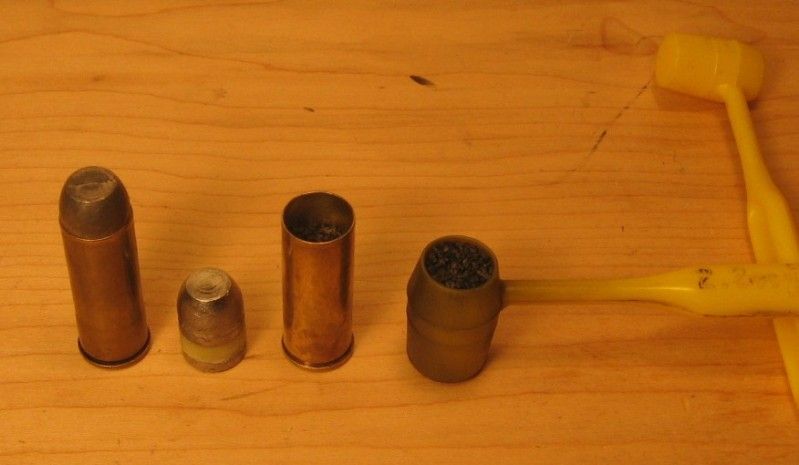
Those are the components to my 45 Colt Black Powder loads. The dipper is a 2.2CC dipper from the Lee dipper set. The set costs $12.98.
Just about everything BLE said is correct. You can weigh Black Powder or you can measure it out by volume. Those guys who insist that BP has to be measured by volume are full of hooey. I have done it both ways for years.
These days I have a Lyman BP measure mounted on my Hornady Lock & Load AP. When I load 45 Colt, 45 Schofield, 44-40, or 38-40 with Black Powder I do it on the Hornady press with the BP measure.
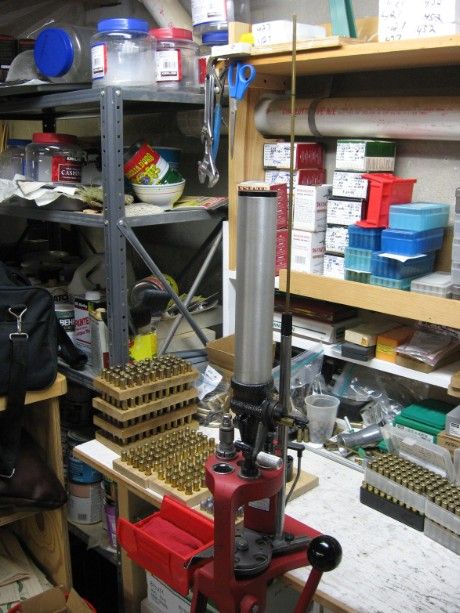
I buy old Lyman 55 Powder Measures at white elephant tables at gun shows. Then I preset the rotors for a specific charge that I use for a specific cartridge.
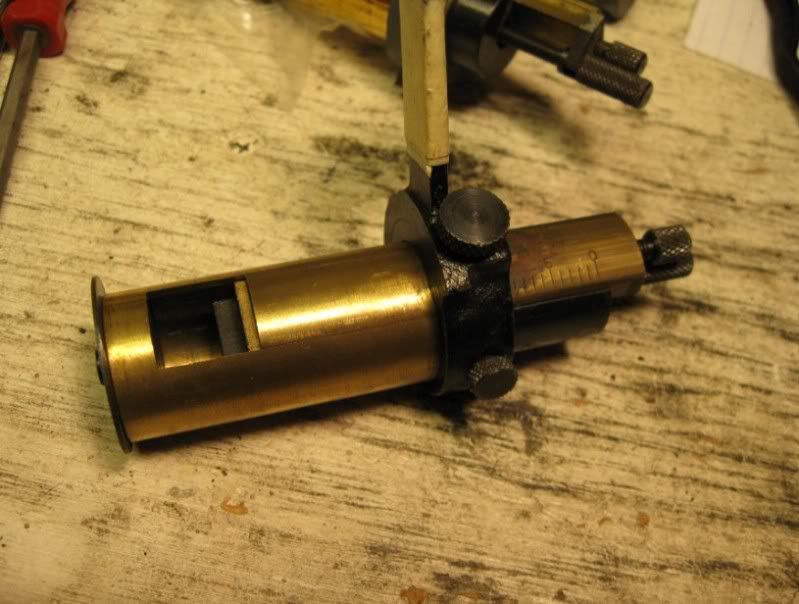
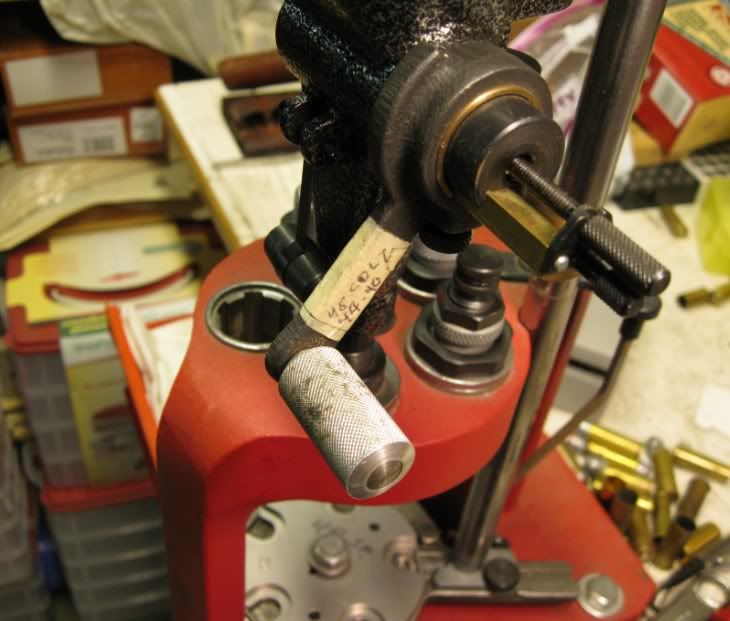
Yes, these rotors are portioning out the powder by volume, no different than a modern Smokeless powder measure does.
And yes, different brands of BP do not weigh the same. In my reloading notebook I keep a table that shows the actual weight of specific charges by volume and brand.
Disclaimer: these powders can vary in weight by lot and date, so take my table with a grain of sand. The point is to show that not all powders weigh the same.
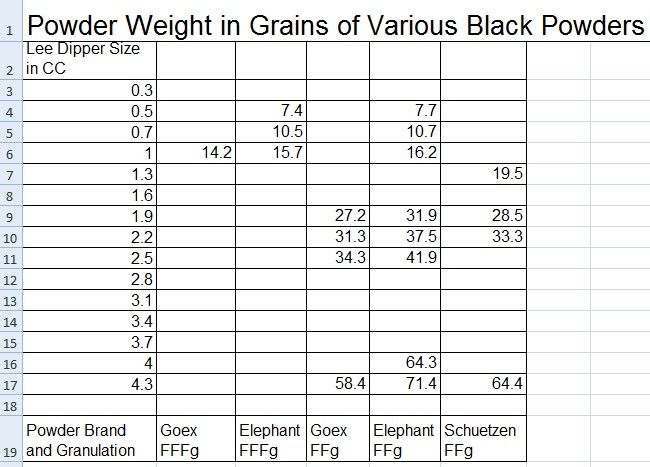
The only slight quibble I have with BLE is his use of the term 'grains by volume'. There is no such thing. At least not in the standard systems of weights and measures used throughout the world. Grains are a unit of weight, or mass. Period. They are not a measure of volume. Using terms like 'grains by volume' or 'grains volume' is an artificial construct used for Black Powder substitutes, as BLE explained very well. It does not exist anywhere else.
stubbicatt
New member
Grains avoirdupois is a measure of weight.
Where I think the divergence here is arriving is more a question of powder measure consistency and further a question of how precisely one must measure black powder to see an effect on the target. I posit that where in smaller charges a tenth of a grain variance of a given smokeless powder may produce marked effects on the target, a tenth of a grain charge weight alone of 2f or even 3f will not.
I arrive at this conclusion from the point of departure that in a 357 magnum cartridge (used as an example) one uses 25 grains of Goex 3f under a 158 grain bullet to get a velocity of 900 feet per second with a 158 grain bullet, according to Goex website load data. 900/25=36. With a 158 grain bullet using 4.5 grains of Unique one gets 859 fps. from the Alliant website. 859/4.5=190.8. This order of magnitude of sensitivity as a function of velocity of propellant is significant.
Ferinstance, 25.2 grains of 3f multiplied by this constant still gives 907 fps, for a difference of 7 fps, where 4.7 of Unique gives 896 fps. for a difference of 37 fps. --I recognize the shortfalls of this analysis, but it illustrates a point. I would think that the natural spread of velocities inherent in the mix even with weighed charges of propellant would exceed 7 fps, and I doubt that 7 fps will make a difference in shot placement on a target at pistol distances.
If one multiplies a couple of charge weights by these constants one can get an idea of how much a couple tenths of a grain difference in charge weight will affect the resultant velocities, and small velocity spread is important to accuracy. The smokeless powder is much more sentitive to a variance in charge weight than black powder, as a function of less mass of propellant provides equivalent energy and velocity.
I posit that at some point of variance in charge weight of black powder one will see a difference in performance, but that black powder can accept a wider range of charge weight variance than can smokeless and still perform the same, as far as human abilities to perceive it can measure or evaluate.
Of greater importance perhaps than a charge weight variance of less than .1 grains with black powder is its consistency. I've seen fellas sifting their powder to assure uniformity in the powder granules they load, and claim that it does make a difference. The manner of pouring the powder will change the load density, and variance in compression will affect its performance more than the 10th of a grain weight variance, or even several tenths of a grain variance.
So whether one weighs each charge of black to the tenth of a grain, or whether one has a powder thrower set to volumetrically throw a charge of the same weight within a tenth of a grain, it would seem to matter less than how the charge is introduced to the chamber, and how the ball is rammed home. Where with smokeless, a closer tolerance of charge weights will generate a greater uniformity of performance, because one does not typically compress smokeless, which tends to perform better with a little air in the case.
I cannot dispute that the high scorers in black powder competition weigh their charges, but I doubt that such a method gives higher scores. It is difficult for me to accept given the propellants nature that this technique alone results in higher scores. I suspect that sifting the powder to remove fines and charging their cylinders in a uniform and consistent manner, and ramming uniform balls in a uniform manner does more for them, as well as installing caps in a uniform manner, fouling mitigation technique... plus other factors I haven't considered. --Plus that those guys are damn fine shots by any standard can't hurt.
Perhaps the weighing of charges is a red herring introduced by those hard holders to distract the unwary from the techniques that are really producing the results?
Where I think the divergence here is arriving is more a question of powder measure consistency and further a question of how precisely one must measure black powder to see an effect on the target. I posit that where in smaller charges a tenth of a grain variance of a given smokeless powder may produce marked effects on the target, a tenth of a grain charge weight alone of 2f or even 3f will not.
I arrive at this conclusion from the point of departure that in a 357 magnum cartridge (used as an example) one uses 25 grains of Goex 3f under a 158 grain bullet to get a velocity of 900 feet per second with a 158 grain bullet, according to Goex website load data. 900/25=36. With a 158 grain bullet using 4.5 grains of Unique one gets 859 fps. from the Alliant website. 859/4.5=190.8. This order of magnitude of sensitivity as a function of velocity of propellant is significant.
Ferinstance, 25.2 grains of 3f multiplied by this constant still gives 907 fps, for a difference of 7 fps, where 4.7 of Unique gives 896 fps. for a difference of 37 fps. --I recognize the shortfalls of this analysis, but it illustrates a point. I would think that the natural spread of velocities inherent in the mix even with weighed charges of propellant would exceed 7 fps, and I doubt that 7 fps will make a difference in shot placement on a target at pistol distances.
If one multiplies a couple of charge weights by these constants one can get an idea of how much a couple tenths of a grain difference in charge weight will affect the resultant velocities, and small velocity spread is important to accuracy. The smokeless powder is much more sentitive to a variance in charge weight than black powder, as a function of less mass of propellant provides equivalent energy and velocity.
I posit that at some point of variance in charge weight of black powder one will see a difference in performance, but that black powder can accept a wider range of charge weight variance than can smokeless and still perform the same, as far as human abilities to perceive it can measure or evaluate.
Of greater importance perhaps than a charge weight variance of less than .1 grains with black powder is its consistency. I've seen fellas sifting their powder to assure uniformity in the powder granules they load, and claim that it does make a difference. The manner of pouring the powder will change the load density, and variance in compression will affect its performance more than the 10th of a grain weight variance, or even several tenths of a grain variance.
So whether one weighs each charge of black to the tenth of a grain, or whether one has a powder thrower set to volumetrically throw a charge of the same weight within a tenth of a grain, it would seem to matter less than how the charge is introduced to the chamber, and how the ball is rammed home. Where with smokeless, a closer tolerance of charge weights will generate a greater uniformity of performance, because one does not typically compress smokeless, which tends to perform better with a little air in the case.
I cannot dispute that the high scorers in black powder competition weigh their charges, but I doubt that such a method gives higher scores. It is difficult for me to accept given the propellants nature that this technique alone results in higher scores. I suspect that sifting the powder to remove fines and charging their cylinders in a uniform and consistent manner, and ramming uniform balls in a uniform manner does more for them, as well as installing caps in a uniform manner, fouling mitigation technique... plus other factors I haven't considered. --Plus that those guys are damn fine shots by any standard can't hurt.
Perhaps the weighing of charges is a red herring introduced by those hard holders to distract the unwary from the techniques that are really producing the results?
Last edited:
Bishop Creek
New member
Thanks for the interesting chart and info Driftwood.
reynolds357
New member
I always weigh my black powder substitute charges. I always use the corrected weight to volume ratio for that particular powder.
For a couple years i experimented with the weighing of charges using the same scoped .50 caliber inline muzzleloading rifle. Compared 100 yard five shot groups of weighed vs volume charges of blackpowder, Pyrodex RS and 777. In some cases weighed charges grouped better than volume charges. But the difference was very small, about 1/8".
Decided that weighing charges was an exercise in futility.
Decided that weighing charges was an exercise in futility.

